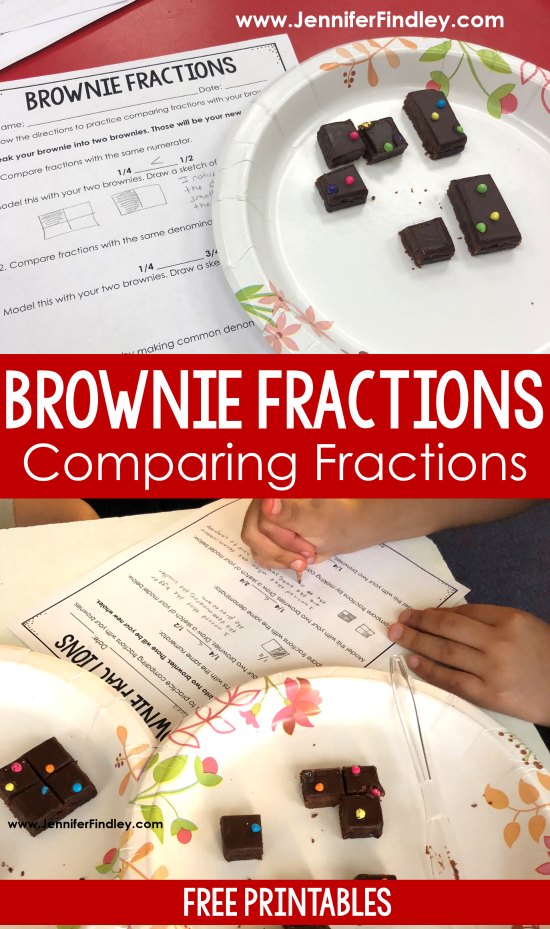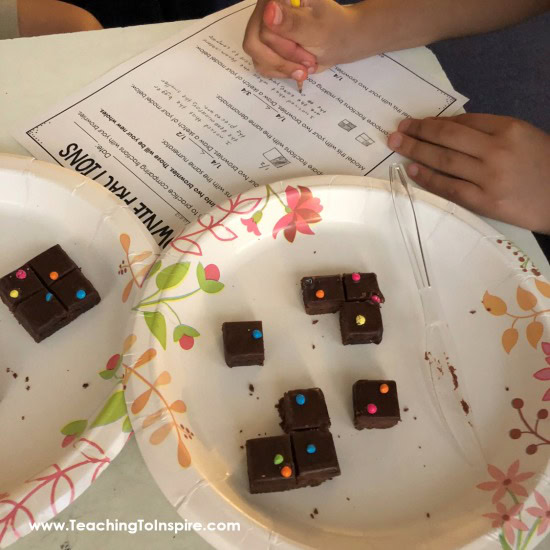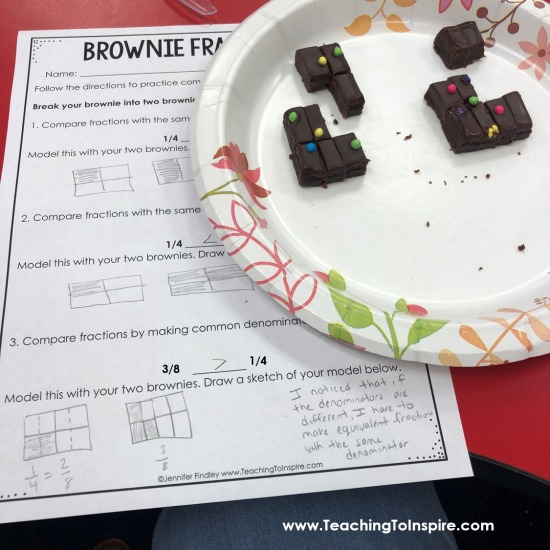One of my goals as a teacher is to make fractions more engaging and relatable to my students. One of the easiest ways I have found to do this is through food. I am fortunate to have always worked in schools that allow food as part of lessons and my students love it. On this post, I will share a comparing fractions activity using brownies that is perfect for 4th grade students (or re-teaching/review for 5th graders).
Note: A prerequisite for this activity is being able to generate equivalent fractions (using models ideally).

Materials Needed:
Brownie Fractions Printable – download at the end of this post.
Plastic Knives – one per student
Paper Plates – one per student
Brownies – 2 per student. I used Little Debbie’s Cosmic Brownies and had the students cut them into two brownies.
Note: To complete the activity, I had my students first cut a Little Debbie brownie into two pieces which became their new wholes. If you think this will be confusing to your students, you may cut the brownies beforehand so they are given two wholes from the start or use two brownies. Whichever you decide, just make sure you choose the correct printable to give the students.
Comparing Fractions Activity Task 1: 1/4 ______ 1/2
This was our first comparison involving comparing fractions with the same numerator, which should have been a review from 3rd grade. We reviewed what numerators and denominators were first and then the students cut one brownie into fourths and one brownie into halves. We then discussed how the halves were larger than the fourths. From there, the students were able to draw the conclusion that the larger the denominator, the smaller the pieces. We also tested a few other fractions to make sure our conclusion was correct.
The students drew a model to represent the math they had done with their brownie and then wrote what we noticed about the denominators from above.
From this task, the students discovered that if the numerators were the same, we could compare the fractions based on the denominator using our new conclusion.
For some reason, I didn’t take a picture of this one. 🙁
Comparing Fractions Activity Task 2: 1/4 ______ 3/4
For the next task, we moved into comparing fractions with different numerators and same denominators (review from 3rd again). Before beginning the task, we talked about how this comparison differed from the first. We discussed how the denominators were the same and what this meant (the pieces were equal in size as long as the wholes were the same). Based on what we knew about numerators, we predicted which fraction was larger and why.
Then, the students took the brownie cut into halves and cut it again to make fourths. Then they were able to compare the fractions and determine if their prediction was correct.
From this task, the students discovered that if the denominators were the same, that meant the pieces were the same size, so you only needed to compare the numerators.
Comparing Fractions Activity Task 3: 3/8 ______ 1/4
Now, that we had reviewed the numerators and denominators and basic review of fractions from 3rd grade, we were ready to move into one of the ways we compare fractions in 4th grade: creating equivalent fractions to compare fractions with different denominators.
For this task, the students were comparing 3/8 and 1/4. Before beginning the modeling with our brownies, we discussed how the denominators and numerators were different so we were not able to compare based on those.
I asked the students what they suggested we do to best compare the fractions. After a few responses, one of the students responded with make the numerator or the denominator the same. From there, we discussed how changing the numerator would change the fractional amount but changing the denominator would only make the pieces smaller (but not change the fractional amount). We then reviewed what we learned about equivalent fractions.
Then, we decided to cut our brownies into eighths so our denominators would be the same. To do this, we took one of the brownies that was cut into fourths and cut it into eighths to make 3/8.
Then we set out with the task of figuring out how many eighths would be equivalent to 1/4. We took our other brownie that was cut into fourths from activity 2 and put one of the fourths slightly above the other fourths (so we would remember how many of our new pieces were equivalent to 1/4). Then we discussed how to cut the fourths into eighths equally. From there, we decided to cut each fourth into two pieces (this was not a stretch for them because this was one of the ways I had taught them to generate equivalent fractions using models).
We also discussed how if you cut one of the fourths into two pieces, you have to cut each piece into two pieces to keep the pieces equivalent. Then the students were able to see that 1/4 was equivalent to 2/8 and they were able to compare 3/8 and 1/4.
Finally, we modeled what we had done on our paper and wrote what we noticed: that if the denominators are different, they need to make equivalent fractions with the same denominator.
Comparing Fractions Extension Printable and Next Steps
After this activity, we then completed an extension 2-page printable (included in the download below) that required the students to apply what they had learned in the activity to compare fractions with same numerators, same denominators, or different numerators and different denominators. They also had to prove their answer for each comparison and could do so with a model, written explanation explaining their reasoning, or both.
My next steps for instruction really depends on how the students do on the extension printable. I typically have a small group to pull to review the 3rd grade comparison skills (comparing with same numerators or same denominators). And then I usually spend the rest of the week doing whole group lessons on comparing fractions by creating equivalent fractions with same denominator (with models, with models and multiplication/division, and then finally with just multiplication/division). I also do mini-lessons on comparing fractions by comparing both to the benchmark fraction 1/2 and comparing fractions by reasoning about how close they are from a whole.
I have my students complete exit slips after each lesson so I can pull small groups and plan my math center groups. You can read more about how I use math groups in two ways by clicking here.
Where Can I Get the FREE Comparing Fraction Worksheets?
Click here or on the image to download the printable shown on this post and the extension printables. Remember that there are two versions of the printable shown on this post, one for having the students cut their brownie into two wholes and one for the brownies already being cut.
Need fraction resources? Check out these resources in my TeachersPayTeachers store:
4th Grade Fraction Review Mini-Booklet: I use this before I begin teaching 5th grade fraction skills. It allows me to make sure my students have the foundation needed. This also works great as an end of fraction review for 4th grade.
Chocolate Themed Fraction Math Tasks: These are perfect for engaging application of fraction skills with a yummy chocolate theme. They are differentiated at two levels – one for fourth grade and one for fifth grade.
4th Grade Fraction Math Centers: This resource includes 23 math centers that cover all of the common core 4th grade math standards.
Fraction Review Task Cards: I love using task cards for SCOOT, math centers, and lots of other purposes. This one-stop task card resource reviews all of the 3rd and 4th grade fraction skills.
Want to read more blog posts about fractions? Click on the titles to check out my other fraction posts.
Fraction Jenga: Want another fun fraction review for 4th and 5th grade? Check out this post for a free Jenga game that reviews fraction skills.
Fraction Mats: Grab some free mats for adding and subtracting fractions with unlike denominators on this post.
Subtracting Mixed Numbers with Regrouping Using Manipulatives: This blog post shares three ways you have help your students subtract mixed numbers in a more concrete way.
Basketball Fraction Review: Check out this post for an engaging way to review 4th grade fraction and decimal skills (and a 5th grade version).
What are some ways you help your students master comparing fractions? Let me know in the comments!










Leave a Comment